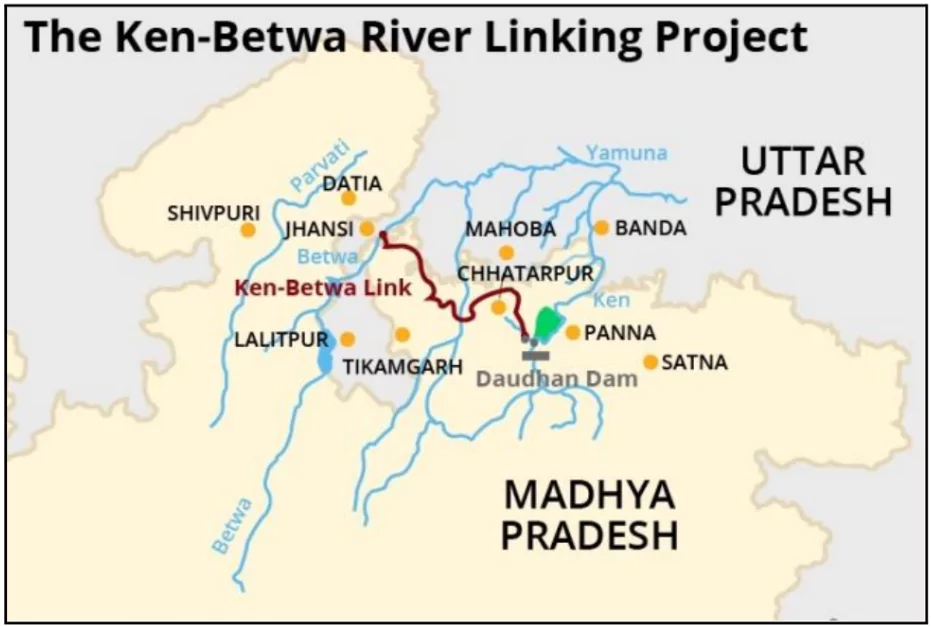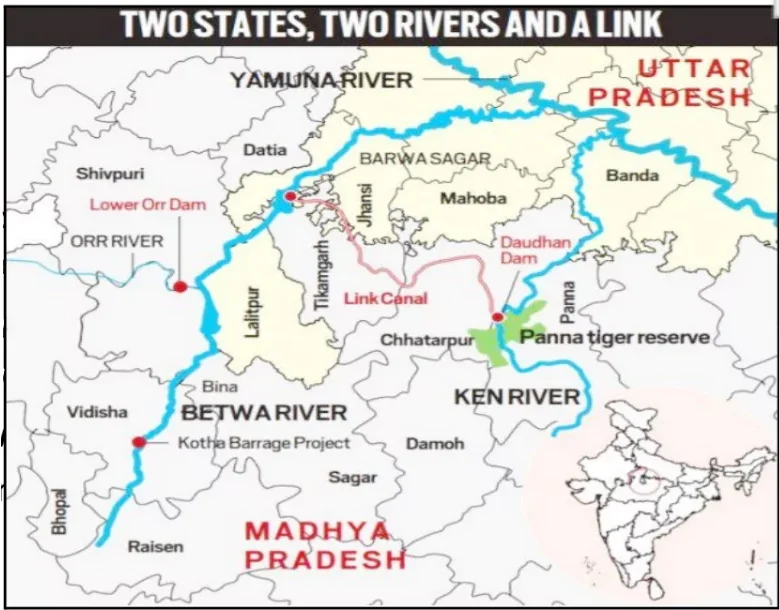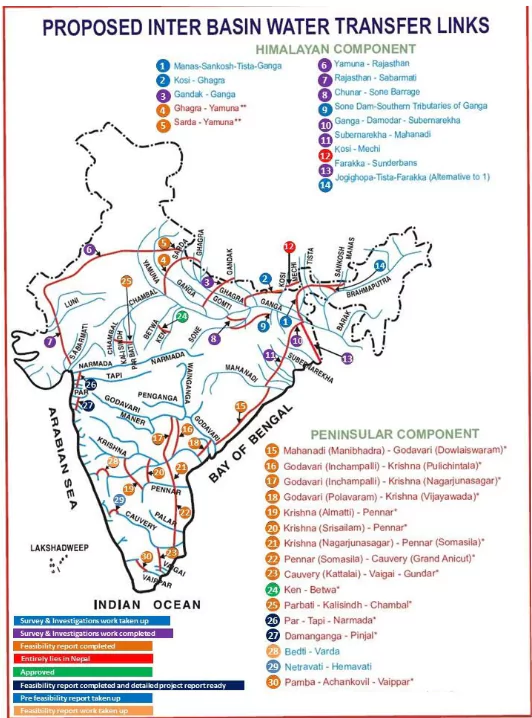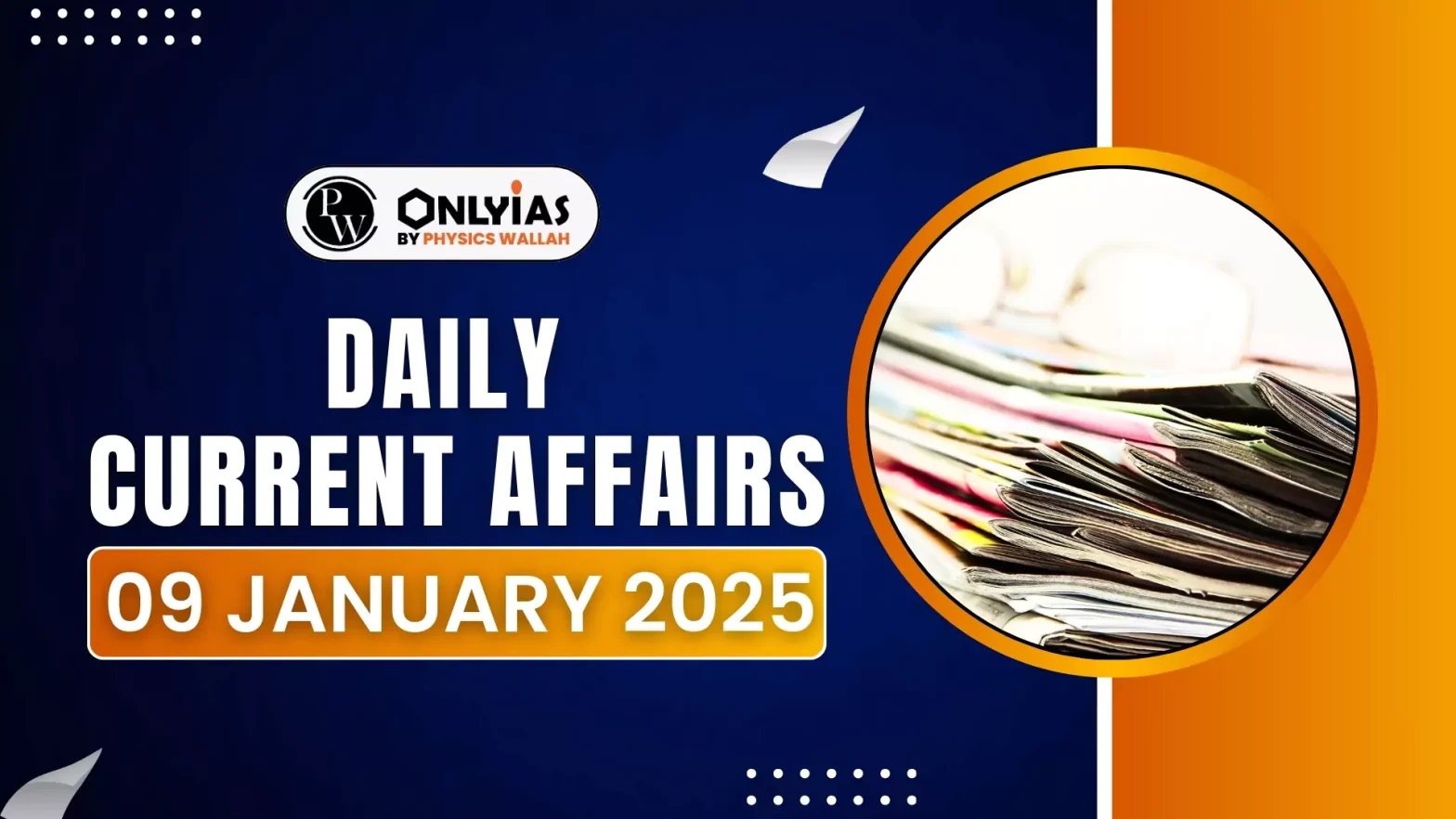The Prime Minister of India launched the Ken-Betwa River Link Project on the 100th birth anniversary of former Prime Minister Atal Bihari Vajpayee.
About Ken-Betwa Project

- The Ken-Betwa Project is a river interlinking initiative designed to transfer surplus water from the Ken River in Madhya Pradesh to the Betwa River in Uttar Pradesh.
- The Union Cabinet had approved Rs 44,605 crore for the KBLP project in December 2021.
- A Special Purpose Vehicle (SPV), the Ken-Betwa Link Project Authority (KBLPA), will oversee the implementation of the project.
- Link Canal Length: 221 km in length, including a 2-km tunnel.
- The Ken-Betwa Link Project has two phases.
- Phase I will involve building the Daudhan Dam complex and its subsidiary units such as the Low-Level Tunnel, High-Level Tunnel, Ken-Betwa Link Canal, and powerhouses.
- Phase II will involve three components — Lower Orr Dam, Bina Complex Project, and Kotha Barrage.
- Benefits:
- Irrigation: The project aims to provide irrigation to Bundelkhand, one of India’s most drought-affected regions.
- According to the Jal Shakti Ministry, the project is expected to provide annual irrigation to 10.62 lakh hectares (8.11 lakh ha in MP and 2.51 lakh ha in UP) of land, supply drinking water to about 62 lakh people
- Power Generation: The project is also aimed at generating more than 103 MW of hydropower and 27 MW of solar energy.
Enroll now for UPSC Online Course
About Ken and Betwa Rivers

- Origin: Both rivers originate in Madhya Pradesh.
- The Ken River starts from the north-west slopes of the Kaimur Range in Jabalpur, Madhya Pradesh, and meets the Yamuna River in Uttar Pradesh’s Banda district.
- The Betwa River originates in the Vindhya Range near Hoshangabad, Madhya Pradesh, flows through Bundelkhand, and joins the Yamuna River at Hamirpur, Uttar Pradesh.
- Tributaries: Both rivers are tributaries of the Yamuna River.
- Dams on Betwa River: Rajghat, Paricha, and Matatila dams are located on the Betwa River.
- Ken River passes through the Panna Tiger Reserve.
|
About River Linking Projects
- River linking projects involve the construction of canals and dams to transfer water from water-surplus river basins to water-deficient basins.
- This is often done to address water scarcity, improve irrigation, and generate hydropower.
- Examples:
- The Volga-Don Canal in Russia: Connecting the Caspian and Black Seas, this canal facilitates navigation and water transfer between the two major river basins.
Historical Background

The concept of river interlinking was first proposed by Sir Arthur Cotton 130 years ago; designed irrigation dams in the Godavari and Krishna river valleys.
- 1972: Dr. K.L. Rao suggested the National Water Grid linking Ganga and Cauvery rivers but was criticized for high costs.
- 1977: Captain Dastur proposed the Garland Canal to connect Himalayan and Peninsular rivers but faced technical challenges.
- 1980: National Perspective Plan (NPP) launched, identifying 30 river links (14 Himalayan, 16 Peninsular) for water transfer.
- 1982: National Water Development Agency (NWDA) established to conduct feasibility studies.
- 2002: Supreme Court, via a PIL, directed the government to expedite interlinking projects.
About National Perspective Plan (NPP)
- The Government of India formulated the National Perspective Plan (NPP) for interlinking rivers in 1980.
- The National Water Development Agency (NWDA) is responsible for executing the interlinking of rivers under the NPP.
- The NPP consists of two components:
- Himalayan Rivers Development Component.
- Peninsular Rivers Development Component.
- A total of 30 link projects have been identified under the NPP.
- 14 Himalayan and 16 Peninsular links.
- The Ken-Betwa Link Project (KBLP) is the first interlinking of rivers project under the NPP and is currently under implementation.
Check Out UPSC CSE Books From PW Store
About National Water Development Agency (NWDA)
- The NWDA is a registered society under the Department of Water Resources, River Development & Ganga Rejuvenation (DoWR, RD&GR), Ministry of Jal Shakti (MoJS).
- It was established in 1982 under the Societies Registration Act of 1860 to conduct detailed studies, surveys, and investigations related to the National Perspective Plan (NPP) for Water Resources Development.
- One of its key functions is to undertake, construct, repair, renovate, rehabilitate, and implement projects under the Pradhan Mantri Krishi Sinchayee Yojana (PMKSY).
|
Why River Interlinking is Needed in India?
- Water Scarcity: A report titled “Composite Water Management Index (CWMI)”, published by NITI Aayog in June 2018, mentioned that nearly 600 million people were facing high to extreme water stress.
- Interlinking can transfer surplus water from rivers like Brahmaputra to drought-prone areas like Rajasthan and Bundelkhand.
- Uneven Water Distribution: 80% of India’s water flows occur during the monsoon, leading to floods in some regions and droughts in others.
- Ganga and Brahmaputra basins experience floods, while Peninsular rivers face water shortages.
- Agricultural Needs: India’s agriculture depends on monsoon rains, which are irregular and unpredictable.
- Interlinking projects can irrigate 35 million hectares of additional land, increasing food security.
- Flood and Drought Management: The economic loss of the floods is estimated to be in the range of Rs 10,000-15,000 crore, as per SBI’s research report, Ecowrap.
- Diverting excess water to water-scarce regions helps mitigate these extremes.
- Urban and Industrial Water Demand: Rapid urbanization and industrial growth have escalated water demand.
- Projects like Damanganga-Pinjal Link aim to supply water to cities like Mumbai.
- Hydropower Potential: India has untapped hydropower potential; ILR can generate 34,000 MW of clean energy.
- Regional Disparities: Resolves water disputes between states by providing equitable water distribution.
- For example, linking rivers in Tamil Nadu and Karnataka to address Cauvery disputes.
- Climate Change Resilience: Erratic rainfall due to climate change affects water resources.
- Interlinking provides a buffer by redistributing water resources across regions.
Benefits of River Interlinking Projects (ILR)
- Improved Irrigation Facilities: ILR aims to irrigate drought-prone areas by transferring surplus water.
- Ken-Betwa Link will provide irrigation to 1.07 million hectares in Bundelkhand, improving agricultural productivity.
- Enhanced Water Supply: Ensures consistent water availability for drinking, industrial, and agricultural use.
- The Damanganga-Pinjal Link is designed to provide drinking water to Mumbai, addressing urban water shortages.
- Flood Control: ILR redistributes excess water from flood-prone areas to deficit regions, mitigating flood damage.
- Diverting water from the Brahmaputra basin can reduce floods in Assam while benefiting arid regions in Rajasthan.
- Hydropower Generation: ILR projects integrate hydroelectric power plants to meet energy demands.
- The Daudhan Dam (Ken-Betwa project) is expected to generate 103 MW of hydropower.
- Economic Growth: Reliable water supply supports industries, agriculture, and employment generation.
- The Polavaram Project in Andhra Pradesh boosts the agricultural economy and attracts industrial investments.
- Groundwater Recharge: Redistribution of water improves groundwater levels in arid regions, ensuring long-term water sustainability.
- The Par-Tapi-Narmada Link is expected to enhance groundwater in water-deficient Gujarat.
- Mitigation of Regional Imbalances: Addressing regional water availability disparities, reducing interstate conflicts.
- Linking rivers in Tamil Nadu and Karnataka can resolve water-sharing disputes and boost cooperation.
- Inland Waterways: Linking of rivers has the potential to significantly enhance inland waterways by creating a continuous navigable network across river basins.
Check Out UPSC NCERT Textbooks From PW Store
Environmental challenges of River Interlinking
- Loss of Biodiversity: River interlinking disrupts natural ecosystems, threatening aquatic and terrestrial species.
- Example: The Ken-Betwa Link endangers wildlife in the Panna Tiger Reserve.
- Common Monsoon Patterns: Most of the rivers typically have surplus water during the monsoon and experience scarcity during the dry season.
- Example: Ganga, Brahmaputra, and Peninsular rivers like Godavari overflow during the monsoon but face reduced flow in summer.
- Disruption of Delta Ecosystems: Reduced sediment flow to deltas can lead to salinity intrusion and loss of fertile lands.
- Example: Indus and Narmada deltas face similar degradation after river diversions.
- Ecosystem Fragmentation: Interlinking may disrupt natural connectivity between rivers, impacting migratory species and sediment flow critical for ecosystems.
- Salinity Intrusion: Reduced freshwater flow increases seawater penetration in deltas, degrading land fertility.
- The Indus Delta faced severe salinity intrusion, land degradation, and loss of fisheries due to reduced freshwater flow from upstream diversions.
- Pollution and Invasive Species: Inter-basin water transfer spreads pollutants and invasive species, affecting aquatic ecosystems.
Socio-Economic challenges of River Interlinking
- Displacement of Communities: Large-scale submergence of villages and agricultural land forces thousands to relocate.
- The Ken-Betwa River Linking Project (KBLP) is expected to displace 6,628 families, with inadequate rehabilitation measures.
- Loss of Livelihoods: Fishing, agriculture, and allied activities dependent on natural river ecosystems are disrupted.
- Reduced freshwater flow in deltas affects fishing communities in regions like the Indus Delta.
- High Financial Burden: Estimated ₹5.5 lakh crore for the National River Linking Project (NRLP), diverting funds from other crucial social welfare projects.
Other Challenges of River Interlinking
- Inter-State Water Disputes: Redistribution of water can exacerbate conflicts between states over water-sharing rights.
- Long-standing disputes like Cauvery water conflict highlight potential issues in interlinking projects.
- Legal and Policy Framework: Lack of a comprehensive central regulatory framework complicates inter-state cooperation and dispute resolution.
Global Examples of Water Diversion Failure:
- The Kissimmee River in Florida suffered extensive wetland loss due to channelization, requiring costly restoration efforts.
- The Aral Sea, once a large lake, became a desert after river diversions for Soviet irrigation projects.
|
Check Out UPSC Modules From PW Store
-
- Water-sharing agreements often stall due to differing state priorities, as seen in the Ken-Betwa Project.
- Climate Change Uncertainty: Erratic rainfall patterns and changing river flow dynamics due to climate change may undermine the reliability of water transfers.
- Donor rivers like the Brahmaputra may face reduced flow in future decades.
- Operational Challenges: Maintenance of massive infrastructure, including dams and canals, requires sustained funding and technical expertise.
- International Implications: Projects involving Himalayan rivers require cooperation with neighboring countries like Nepal and Bhutan, complicating negotiations.
- Example: India-Nepal cooperation is essential for Himalayan river interlinking projects like the Saptakosi-Sun Kosi Link, but concerns over submergence and benefit-sharing hinder progress.
- Cultural and Ideological Conflict: The river interlinking project contradicts the religious ideology, which views rivers as sacred entities.
Successful Case Studies of River Interlinking
- Tennessee Valley Authority (USA): A comprehensive river basin management project that interlinked rivers for navigation, flood control, and hydropower.
- Successfully revitalized the region’s economy by boosting agriculture, industries, and employment.
- Mekong River Basin (Southeast Asia): Inter-basin water transfer facilitated agriculture and energy production in Laos, Vietnam, and Cambodia.
- Created regional cooperation, balancing water-sharing needs among countries.
|
Way Forward for River Interlinking Projects in India
- Comprehensive Environmental Impact Assessments (EIA): Conduct detailed EIAs to assess and mitigate ecological damage, biodiversity loss, and salinity intrusion.
- Ensure implementation of Environmental Management Plans (EMP) and restoration initiatives.
- Equitable Water Sharing Mechanisms: Develop a robust legal framework to address inter-state disputes and ensure fair distribution of water resources.
- Establish a central authority under Entry 56 of the Union List of Sch. 7 (Constitution) for streamlined decision-making.
- Focus on Sustainable Alternatives: Prioritize localized solutions like watershed management, rainwater harvesting, and micro-irrigation to complement river interlinking.
- Promote high-efficiency irrigation systems such as drip and sprinkler irrigation.
- Virtual Water Trade (VWT): Reduces the need for extensive interlinking infrastructure by addressing water scarcity through trade.
- Virtual Water Trade involves importing water-intensive goods from regions with abundant water to conserve water in deficit regions.
- Improved Rehabilitation and Resettlement (R&R) Policies: Provide adequate compensation, employment opportunities, and social support for displaced communities.
- Include affected populations in the planning process to address their concerns.
- Leverage Modern Technology: Use satellite imagery and GIS tools for precise planning and monitoring of river interlinking projects.
- Implement real-time water flow management systems to ensure efficiency and minimize wastage.
- Climate Resilience Planning: Incorporate climate change models to predict rainfall variability and ensure long-term viability of water transfers.
- Avoid over-reliance on perceived “surplus” water in donor rivers.
- Phased Implementation and Pilot Projects: Begin with smaller, region-specific links to demonstrate viability and learn lessons before scaling up.
- Accelerate work on priority links like Ken-Betwa and Par-Tapi-Narmada.
Enroll now for UPSC Online Classes
Conclusion
Rivers provide critical ecosystem services, including sediment transport for delta formation, support for biodiversity, enhancement of land fertility, and groundwater recharge. Policymakers must balance technological interventions with environmental sustainability to ensure the long-term ecological and societal health of the nation. River interlinking projects must align with climate change mitigation strategies to avoid irreversible damage to natural systems.
![]() 9 Jan 2025
9 Jan 2025



